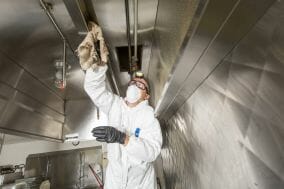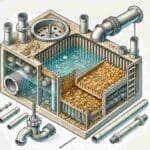Commercial Kitchen Hood Cleaning – Everything you Need to Know

Grease and other airborne food particulate are nothing more than a trivial, mundane part of life for most people. In a commercial kitchen setting they are far more dangerous and should never be trivialized. As food is cooked, bits of it will travel upward and stick to the kitchen hood. This is largely because heat rises – there is a localized convection current that takes the airborne food particles upward. When they stick to the hood and have a chance to cool, they become adhered to the surface. Most modern kitchens, whether they be domestic or commercial, are equipped with a hood fan to help manage this. As the vapors approach the hood, the filter catches the larger particulate, while what remains gets sucked away and vented outward. Cleaning the hood and filter, as well as the fan and vents, are basic household chores that most of us do only once in a while. But thankfully, there are lots of options for commercial kitchen hood cleaning near me to make sure this does not get out of control in your commercial kitchen.
Why it is more of a problem in commercial kitchens?
In a restaurant, bar or dining hall, food is being prepared constantly. This means that there is an enormous volume of airborne grease that is constantly in motion. A typical commercial kitchen will have fans capable of displacing more air and larger sized filters to accommodate this. The high volume also creates the need for ductwork, instead of the lower-profile systems that do not use ducts seen in households. Commercial hoods usually have a gutter that collects liquefied grease that flows toward the kitchen’s grease trap. When searching for the right provider of commercial kitchen hood cleaning near me, it is important to choose someone that understands all of these dynamics well.
As one might expect, the solidified grease that collects on the filter, along the grease gutter and inside the ducts, will clog things up with time. Because grease is highly flammable, all of this is likely to catch fire at some point. If you are lucky, some grease fires are minor and can be handled with a simple fire extinguisher. A more realistic, not so lucky kind of grease fire will involve a call to the local fire department. Minimal smoke and fire damage might permit the kitchen to reopen after a week or 10 days. More severe damage sometimes requires a partial reconstruction of the building’s roof and the involvement of your insurance company. Many severe grease fires will begin with the hood and filter, but instead of staying localized, will travel down the gutter toward the grease trap. If the grease trap is not too full or clogged with grease, it should not catch fire. However, if the lines are clogged with grease, they will act as a wick and spread the fire to the kitchen floor. This same effect can cause the clogged grease deposits within the ductwork to spread the fire toward the roof. If the ducts are leaky and there is grease on the roof, the roof will likely catch fire. When this happens, the best-case scenario is some fire damage that can be fixed with minimal reconstruction. The worst-case scenario is the entire building going up in flames. This is what all of the businesses that provide commercial kitchen hood aim to prevent.
The National Fire Protection Agency (NFPA) recommends that most hoods be cleaned four to six times per year. One reason for the variation in cleaning frequency is that a fast food restaurant that serves burgers and fries will generate more grease than a bistro that does mainly pasta and salads. Another is that many kitchens will have a prep grill, where things like vegetables will be sauteed, and a main grill where meat or fish gets cooked. The hood above the prep grill will not need as much cleaning as the one for the main grill, so typically the different hoods are cleaned on separate schedules. A quality provider of commercial kitchen hood cleaning will use a combination of chemical degreasers, and high pressure washing and scrubbing to remove everything. They should spend as much time cleaning the ducts above the hood as they spend on the hood itself. The NFPA also makes other recommendations for cleaning based on hood grease thickness.







